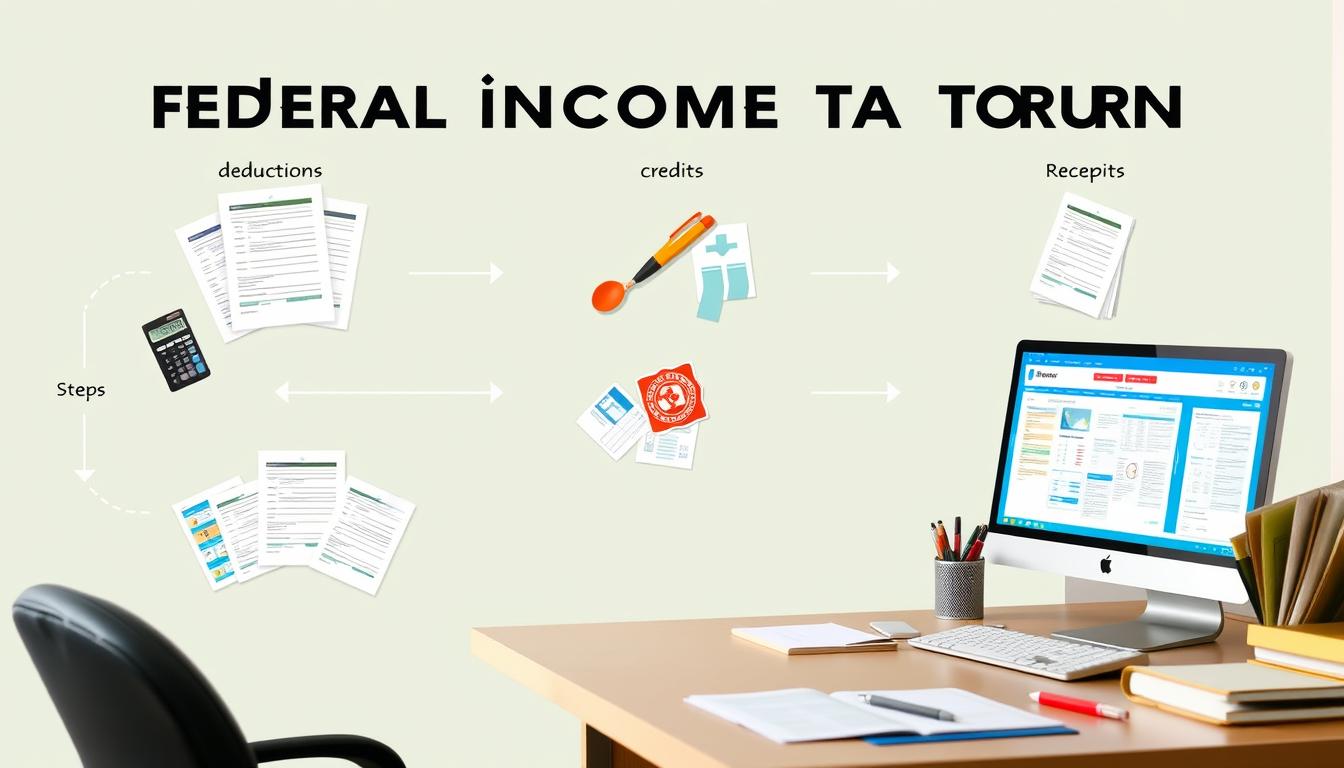Filing back taxes doesn't have to be overwhelming. Start by gathering documents like your W-2s and 1099s. Then, calculate your taxable income, ensuring you apply any deductions you can. Download the appropriate tax forms from the IRS website for the years you're filing. Fill them out carefully, checking your entries against your financial records for accuracy. Finally, choose whether to file electronically or by mail, and submit your return along with any payment you owe. Once you get these initial steps down, you'll be better prepared for what comes next.
Key Takeaways
- Gather all necessary documents, including W-2s, 1099s, and any relevant deduction receipts for the back tax years.
- Use the correct tax forms for each year you are filing; past years cannot be e-filed and must be submitted by mail.
- Calculate your taxable income for each year by summing total income and applying any deductions, ensuring accuracy against IRS transcripts.
- Submit your completed tax returns for each year to the IRS, including any payments owed to avoid additional penalties and interest.
- Consider seeking assistance from a tax professional to navigate complex situations or to ensure compliance with IRS requirements.
Gathering Necessary Documents

When you're ready to file back taxes, the first step is gathering all necessary documents. Start with your W-2 forms, which show your wage and tax statements from employers. If you've worked as a contractor or received other income, collect your 1099 forms, including 1099-G for unemployment benefits and 1099-INT for interest income.
Don't forget the SSA-1099 for Social Security benefits and any 1098 forms for mortgage interest or tuition expenses.
Next, compile personal information. You'll need Social Security numbers or ITINs for yourself, your spouse, and any dependents. Gather names, dates of birth, and addresses as well. Knowing your marital status helps determine your filing status, so keep that in mind. Filing past-due taxes can help you claim potential refunds owed from previous years, typically within three years.
If you're missing any documents, don't panic. Request an IRS tax transcript if originals are unavailable, using Form 4506-T for older years. Reach out to your employers or financial institutions for missing forms, and check with state tax authorities if needed.
Finally, organize records for deductions. Collect receipts for medical expenses, charitable donations, and any significant payments made toward taxes.
This preparation sets a solid foundation for your back tax filing process.
Determining Taxable Income

Determining your taxable income is crucial for accurately filing your back taxes. Start by calculating your gross income, which includes all earned income like wages, tips, and bonuses, as well as unearned income such as interest and dividends.
Don't forget to include government benefits, strike benefits, and any earnings from sold appreciated assets.
Next, identify what's taxable and what's not. Taxable income encompasses canceled debts, capital gains, and certain government benefits, while nontaxable income includes life insurance benefits and certain awards.
Remember, if you're a dependent, personal exemptions don't count.
Adjust your gross income by applying deductions. You can choose between the standard deduction or itemized deductions, which may include mortgage interest and certain medical expenses. Most income is considered taxable income, except for specific situations such as gifts and inheritances.
Also, contributions to retirement accounts or flexible spending accounts can help lower your taxable income.
Finally, once you've determined your taxable income, refer to the tax brackets relevant to your filing status. This will help you figure out your applicable tax rate and how much you owe or might get refunded.
Taking these steps ensures you're prepared to file your back taxes accurately.
Obtaining Tax Forms

Obtaining the necessary tax forms is a vital step in filing your back taxes. You can easily download federal tax forms from the IRS website at IRS.gov. There, you'll find forms for both current and prior years, organized by form number or year. You can print or save them digitally, along with instructions and publications.
If you prefer receiving forms by mail, you can order them online or call 1-800-TAX-FORM (1-800-829-3676). When you order, you'll receive forms for both current and previous years, complete with instructions.
Additionally, local community centers often provide access to tax forms. Check your public library or other community hubs for free copies that you can pick up in person.
For state tax forms, visit your state tax agency's website, where you'll find downloadable forms and specific mailing addresses. You can also access forms through tax preparation services or order them by mail or phone from your state's agency.
Make sure you gather all necessary forms before you start the filing process, as this will help streamline your efforts in resolving your back taxes. Prior-year returns cannot be e-filed; they must be mailed as paper forms.
Completing Tax Forms

Completing tax forms for back taxes can seem daunting, but breaking it down into manageable steps makes the process more straightforward.
Start by gathering all necessary information. Request wage and income transcripts from the IRS to pinpoint data from Tax Forms W-2 and 1099. Don't forget to collect details about self-employment income, investments, and any other income not reported to the IRS.
Next, ensure you're using the correct tax forms for the specific tax year. Remember, forms for previous years can't be e-filed. As you fill out the return, double-check your entries against IRS transcripts and your financial documents. Include all relevant attachments, like penalty relief requests if needed. Additionally, make sure to obtain your W-2 forms as they reflect your income and taxes withheld for accurate reporting.
Make sure your filing status, exemptions, and deductions are accurate and consistent with your federal return or adjusted for state taxes. If you have special tax situations, like self-employment tax, include the necessary additional forms.
Use tax calculators and tools to help verify that all income, withholdings, and estimated payments are accounted for. Finally, don't forget to sign and date your return before mailing it to the IRS or your state tax agency.
Filing Your Tax Return

How do you ensure your tax return is filed accurately and on time? Start by gathering all necessary documents. Collect your W-2 forms from employers, 1099 forms for any freelance work, and receipts for deductions like mortgage interest and charitable donations.
Don't forget to have Social Security numbers for yourself, your spouse, and dependents ready.
Next, choose your tax filing method. You can file online using tax preparation software, opt for a paper return mailed by hand, or hire a tax preparer. If you qualify, consider the IRS Free File program for free online preparation.
Determine your filing status, as it affects your standard deduction and tax bracket. The five statuses include single, married filing jointly, married filing separately, head of household, and qualifying widow(er) with a dependent child.
Once that's set, calculate your taxable income by subtracting eligible deductions from your total income. Use tax tables or calculators to find your tax liability. Stay aware of document deadlines annually to avoid penalties.
Finally, submit your tax return electronically or by mail, ensuring you include all required forms and schedules. If you owe, include payment; if you're due a refund, request it.
Frequently Asked Questions
What Happens if I Can't Find My W-2 or 1099 Forms?
If you can't find your W-2 or 1099 forms, don't panic.
Start by contacting your employer or the entity that issued the 1099 to request a copy. If they don't respond, reach out to the IRS for assistance.
You can also use Form 4852 as a substitute for the W-2, estimating your income and withholding from your final pay stub.
Can I File Back Taxes for Multiple Years at Once?
You can't file back taxes for multiple years at once. Each tax year must be filed separately, using the specific forms for that year.
It's crucial to gather all necessary information for each year, ensuring your returns are accurate. While it may seem tedious, this process helps you stay compliant and reduces potential penalties.
Make sure to double-check everything before mailing your returns to the appropriate IRS address.
How Do I Check the Status of My Filed Back Taxes?
To check the status of your filed back taxes, you can use the IRS Where's My Refund tool online.
Just enter your Social Security number, filing status, and the exact refund amount.
If you prefer, you can also call the IRS at 800-829-1040, but be ready for long wait times.
Alternatively, visit an IRS Taxpayer Assistance Center for in-person help.
Keep your details handy to streamline the process.
Will Filing Back Taxes Affect My Credit Score?
Filing back taxes won't directly affect your credit score since the IRS doesn't report tax debt to credit bureaus.
However, if you don't pay and a tax lien is placed, it could indirectly impact your score because creditors can see it.
Remember, unpaid taxes might lead to financial stress, causing missed payments on other debts, which definitely could hurt your credit score.
Staying proactive with your tax obligations helps maintain a healthier financial profile.
What if I Owe Taxes but Can't Afford to Pay?
If you owe taxes but can't afford to pay, don't panic. You can set up an installment agreement with the IRS, allowing you to pay in manageable installments.
Alternatively, you might qualify for the IRS Hardship Program, which temporarily halts collection actions.
Just remember, interest and penalties will continue to accrue.
It's crucial to gather your financial documents and communicate with the IRS about your situation for the best resolution.
Conclusion
Filing back taxes can seem daunting, but you've got the tools to tackle it. By gathering your documents, determining your income, and completing the right forms, you're on your way to getting things sorted. Don't forget to double-check everything before you submit. If you need help, consider reaching out to a tax professional. Taking these steps not only helps you stay compliant but also puts you in a better financial position moving forward.









